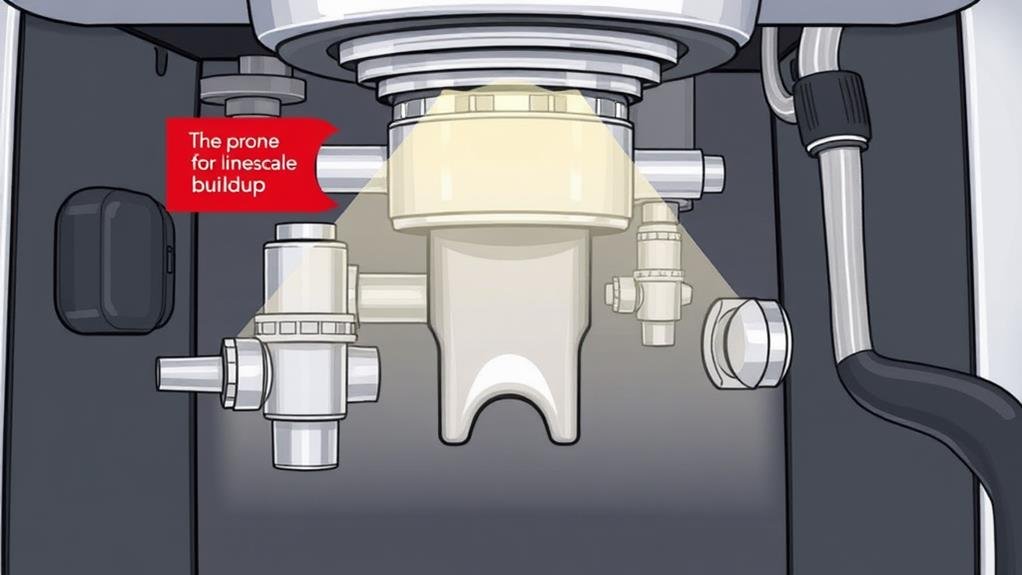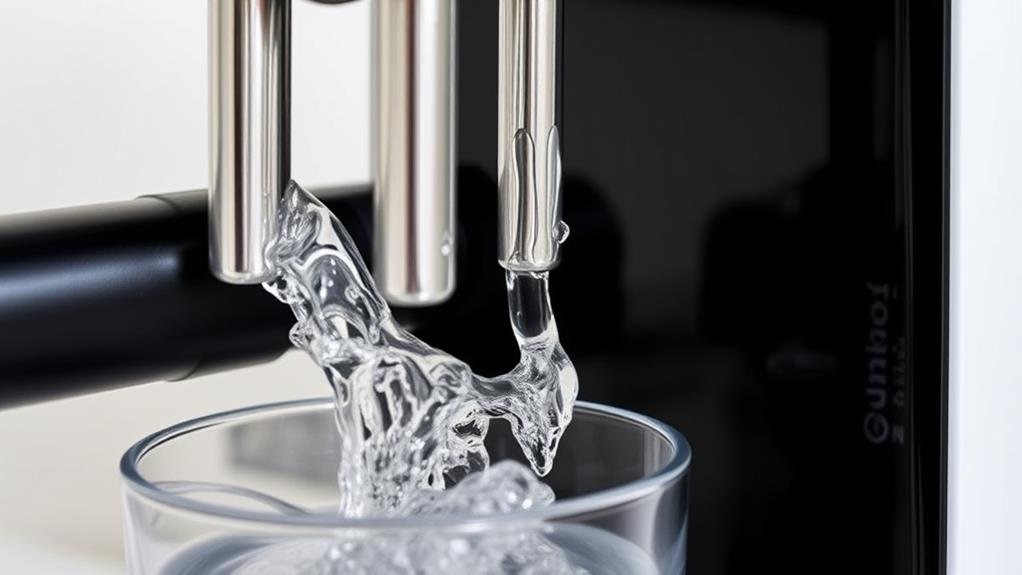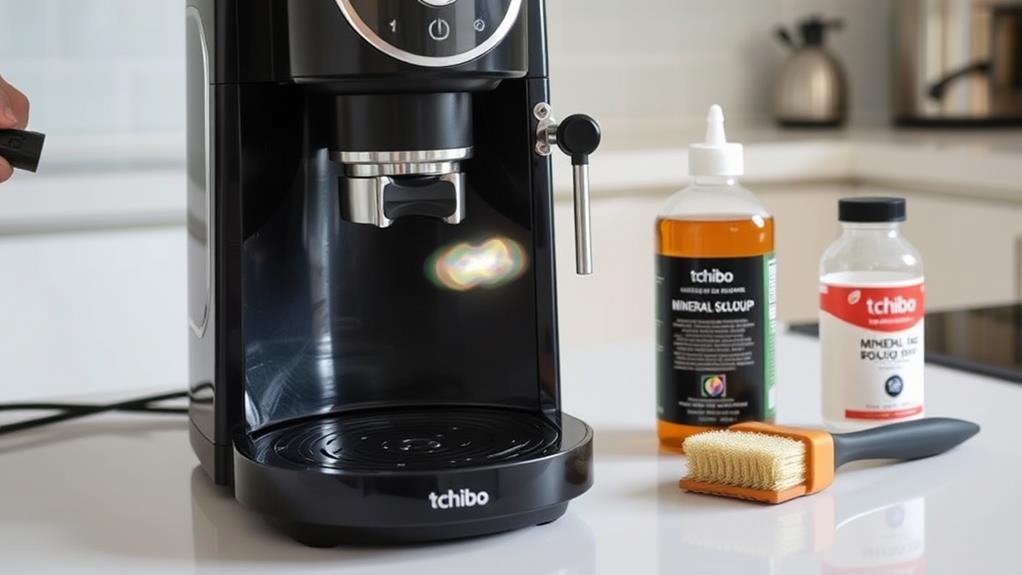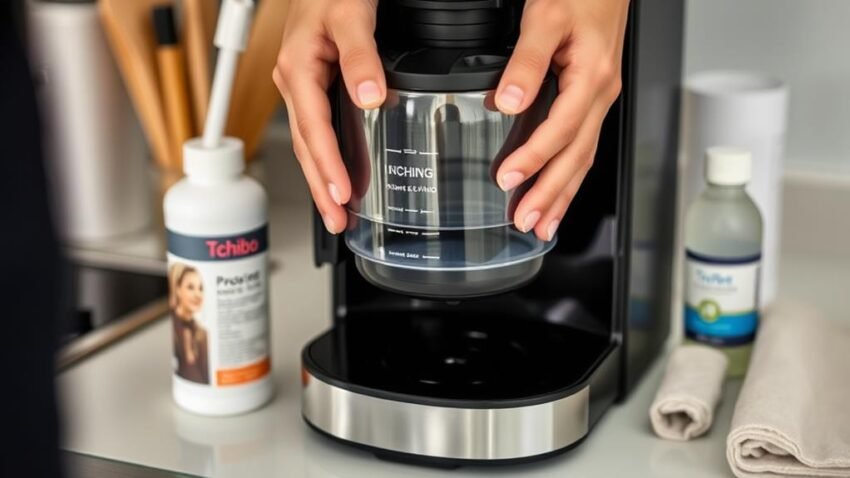To descale my Tchibo coffee machine, I start by gathering the necessary supplies, including a descaling solution, container, cloth or sponge, user manual, and fresh water. I then empty the water tank completely and prepare the descaling solution according to the manufacturer's instructions. Next, I run the descaling cycle to remove limescale buildup, followed by a thorough rinse to make sure all residues are removed. By descaling my Tchibo machine regularly, I can prevent clogged internal components, inconsistent coffee quality, and prolong the machine's lifespan. To achieve top-notch performance, I'll want to explore the specifics of the descaling process further.
Understanding Your Tchibo Machine

Before diving into the descaling process, it is important to get familiar with my Tchibo coffee machine. I need to understand its components and features to make sure I descale it correctly. My Tchibo machine has a built-in descaling indicator that alerts me when it's time to descale. This feature is useful, as it helps me stay on top of maintenance and prevent limescale buildup.
I've learned that descaling is necessary to maintain my machine's performance and longevity. If I neglect to descale, limescale deposits can affect the taste of my coffee and even damage the machine over time. To avoid this, I make sure to follow the manufacturer's instructions for descaling. This way, I can make sure I'm using the correct method and materials to remove limescale buildup without harming my machine.
Importance of Regular Descaling
Now that I've got a good understanding of my Tchibo machine's components and features, I can see why regular descaling is so essential. Limescale buildup can greatly impact the taste of my coffee and the overall performance of my machine. If I don't descale on a regular basis, limescale can clog internal components and hinder water flow, which affects the brewing process. This can lead to inconsistent coffee quality, and I may notice a change in the flavor of my coffee.
Regular descaling helps prevent blockages in the system, ensuring that my coffee tastes great every time. It also prolongs the lifespan of my Tchibo coffee machine. By following the recommended descaling schedule outlined in the manual, I can maintain the best brewing conditions and prevent limescale buildup. Descaling is an essential maintenance task that I need to perform regularly to keep my machine in good working order. By doing so, I can enjoy great-tasting coffee and extend the life of my machine. I'll make sure to prioritize descaling to keep my Tchibo machine running smoothly and efficiently.
Gathering Necessary Supplies

To effectively descale my Tchibo coffee machine, I need to gather a few essential supplies. First, I'll need a descaling solution specifically crafted for coffee machines. This solution will help break down mineral deposits that have accumulated inside the machine. I'll also need a container large enough to hold the descaling solution and water mixture. This will guarantee I can properly mix the solution according to the manufacturer's instructions.
Additionally, I'll have a clean cloth or sponge ready for wiping down the machine during the descaling process. This will aid in removing any mineral deposits or residue that may be left behind. I'll also keep the user manual for my Tchibo coffee machine handy, as it will provide specific descaling instructions for my particular model. Finally, I'll make sure I have access to clean, fresh water for rinsing the machine after descaling. By having all these supplies on hand, I'll be able to complete the descaling process efficiently and effectively.
Emptying the Water Tank
One significant step I need to take is emptying the water tank completely to make certain the descaling solution can effectively reach all internal components of my Tchibo coffee machine. I'll start by carefully lifting the water tank out of the machine and pouring out any remaining water. It's important to verify the tank is free of any water or coffee residue before proceeding with the descaling process. To double-check, I'll tip the machine slightly to guarantee it's fully emptied.
Properly emptying the water tank is crucial to effectively descale the internal components of my coffee machine. If I don't remove all the water, the descaling solution may not reach all the areas it needs to, which could lead to poor descaling results. To avoid any issues, I'll follow the manufacturer's instructions on how to safely and efficiently empty the water tank. By taking the time to thoroughly empty the water tank, I'll be able to ensure a successful descaling process and keep my Tchibo coffee machine in top condition. This simple step is a vital part of maintaining my machine and making sure it continues to produce great-tasting coffee.
Preparing Descaling Solution

Preparing the correct descaling solution is vital for effectively removing mineral deposits from my Tchibo coffee machine. I always look for the descaling symbol on the packaging to make sure I'm using the appropriate solution specifically designed for my machine. To prepare the solution, I follow the manufacturer's instructions for the accurate dilution ratio with water. It's crucial to get this ratio right, as using too much or too little solution can impact the descaling process.
I fill the water tank with the prepared solution, ensuring not to overfill it. I avoid using vinegar or other harsh chemicals, as they can harm my machine's internal components. It's also important to use only Tchibo-approved descaling solutions to guarantee my machine remains in good condition. By following these simple steps, I can confidently move on to the next stage of the descaling process, knowing my solution is ready to tackle tough mineral deposits. I carefully review the manufacturer's guidelines one last time to confirm I've prepared the descaling solution correctly. With the solution prepared, my machine is one step closer to being descaled.
Running the Descaling Cycle
Running the descaling cycle is the next crucial step in removing mineral deposits from my Tchibo coffee machine. Now that I've prepared the descaling solution according to the manufacturer's instructions, I'm ready to run the cycle. My machine's display panel will prompt me to start the descaling process, and I'll follow the on-screen instructions.
| Descaling Step | Action |
|---|---|
| 1. Initiate descaling cycle | Press the button with the descaling symbol |
| 2. Allow descaling solution to flow | Let the solution run through the entire system |
| 3. Complete the cycle | Follow on-screen instructions to finish the descaling process |
As the descaling solution flows through the machine, it will remove limescale buildup and other mineral deposits. It's crucial to let the solution run through the entire system to make sure all areas are cleaned. I'll follow any additional instructions provided in the user manual to achieve optimal descaling results. Once the cycle is complete, I'll be one step closer to having a clean and descaled Tchibo coffee machine.
Rinsing the Machine Thoroughly

Now that I've completed the descaling cycle, I'll focus on removing any remaining descaling solution from my Tchibo coffee machine. To do this, I'll thoroughly rinse the machine with clean, fresh water. It is crucial to rinse all parts of the machine, including the water reservoir and brewing unit, to make sure that all traces of descaling solution are flushed out. I'll take extra care to rinse the water tank multiple times to eliminate any lingering descaling solution.
Proper rinsing is vital to maintain the performance and longevity of my Tchibo coffee machine after descaling. Any remaining descaling solution can impact the taste of my coffee, so I want to ensure I remove it all. I'll continue to rinse the machine until I'm confident that all parts are free from any residue. By doing so, I'll be able to enjoy great-tasting coffee and extend the life of my machine. After completing the rinsing process, I'll be confident that my Tchibo coffee machine is clean and ready for use.
Maintaining Your Tchibo Machine
The key to a long-lasting and high-functioning Tchibo coffee machine lies in regular maintenance. I make it a point to descale my machine regularly, as it helps remove mineral buildup and maintain peak performance. Descaling is an essential part of maintenance, and I use descaling agents recommended by Tchibo to effectively remove limescale deposits. By following the machine's display prompts or manual instructions, I can determine the right frequency for descaling.
Proper descaling prevents clogs, improves water flow, and enhances the taste of my coffee. Regular descaling also prolongs the life of my machine, ensuring I get the best quality coffee for years to come. I've found that descaling is a simple process that makes a significant difference in the performance of my Tchibo machine. By incorporating descaling into my maintenance routine, I can enjoy great-tasting coffee every time. To keep my machine in top condition, I prioritize descaling and make it a regular part of my maintenance schedule. This way, I can guarantee my Tchibo coffee machine continues to deliver high-quality coffee for a long time.
Troubleshooting Common Issues

Several issues can arise when descaling my Tchibo coffee machine, but most are easily resolved with some basic troubleshooting. If I encounter a problem, I start by unplugging the machine and plugging it back in to reset it. This often resolves the issue, but if the machine is stuck in descaling mode, I search for "Descaling" on the Tchibo website for specific solutions. I also refer to my Tchibo manual, which provides step-by-step guidance on troubleshooting descaling issues.
For more persistent problems, I contact Tchibo customer support for further assistance. Additionally, I explore online forums to find similar issues and potential solutions. Addressing any descaling challenges promptly is necessary to ensure the longevity of my machine. Regular cleaning and descaling are vital for maintaining my Tchibo coffee machine's performance and preventing limescale buildup. By following these troubleshooting steps and staying on top of cleaning and maintenance, I can enjoy a perfectly brewed cup of coffee every time. By taking proactive steps, I can prevent issues and maintain my machine's optimal functionality.
Conclusion
"I've walked you through the process of descaling your Tchibo coffee machine, and now it's humming along like a well-oiled engine. Regular descaling is key to preventing mineral buildup and maintaining your machine's performance. By following these steps, you'll be able to enjoy great-tasting coffee and extend the life of your machine. Remember to descale every 3-6 months to keep your Tchibo running smoothly. Stay on top of maintenance and your machine will reward you with perfect brews every time."

